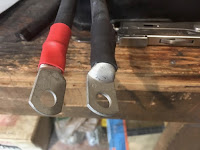This morning was a very pleasant +20°F (-7°C). Warm enough to get out on the Ural and not be concerned about leaving it outside for a while. I just went down to College Coffeehouse and the gas station plus a loop through the university to get the engine warmed up before heading home.
Today's afternoon activity is making more battery cables and connecting the battery bank. For now, I have the plywood board with the inverter and charge controller hanging on some wooden shelves in the back of the garage. On Sunday, I checked Sam's Club to see if they had gotten any more golf cart batteries in stock. Last month, they only had three of each brand on the shelf. I wanted to get all four at the same time so they get used at the same rate. These are Duracell GC2 6 volt golf cart batteries rated at 215 amp-hours at the 20 hour discharge rate. They fit nicely in the plastic battery box though I may need to modify the lid to get it to fit. It depends on the height of the front compartment.
Equally important is making sure that the cables being used to interconnect the batteries within your bank are the same length. It kind of looks like these two cables making the series connection are different lengths but they are exactly (within 1 mm) the same length when laid out on the workbench. These connect the positive on one battery with the negative on the adjacent battery making the pair of 6 volt batteries into a single, 215 amp-hour 12 volt battery. So the bank will be 430 amp-hours with 50% of it actually useable without damaging the batteries.
I need to pick up eight more 2/0 awg cable lugs and shrink wrap to finish the battery bank and connect it to the inverter/charge controller setup. Also some large rubber grommets to protect the 2/0 wire where it exits the plastic battery box. I will be borrowing a Kyocera 135 watt, 12V solar panel (7.6 amps) to test out the charge controller.
Equally important is making sure that the cables being used to interconnect the batteries within your bank are the same length. It kind of looks like these two cables making the series connection are different lengths but they are exactly (within 1 mm) the same length when laid out on the workbench. These connect the positive on one battery with the negative on the adjacent battery making the pair of 6 volt batteries into a single, 215 amp-hour 12 volt battery. So the bank will be 430 amp-hours with 50% of it actually useable without damaging the batteries.
I need to pick up eight more 2/0 awg cable lugs and shrink wrap to finish the battery bank and connect it to the inverter/charge controller setup. Also some large rubber grommets to protect the 2/0 wire where it exits the plastic battery box. I will be borrowing a Kyocera 135 watt, 12V solar panel (7.6 amps) to test out the charge controller.






























